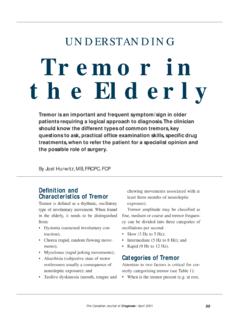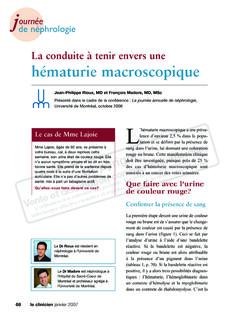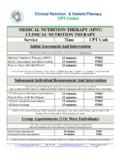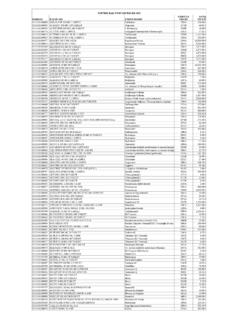Transcription of Getting Started: Elevated Serum Creatinine
1 ApproachCLINICALNeil Finkle, MD, FRCPCP resented at the 78th Annual Dalhousie Refresher Course, 2004 Getting started : Elevated Serum CreatinineSome 810 Canadian patients/million population requiredrenal replacement therapy (dialysis and transplant) projected increase in annual incidence rate is %.2 Creatinine can be Elevated in several conditions (Table 1). Acuterenal insufficiency (ARI) is defined as a rise in Serum creatinineover a period of days to weeks. ARI is a medical emergency andrequires urgent assessment by a nephrologist or other qualified specialist. Chronic renal insufficiency (CRI), also known as chron-ic kidney disease (CKD), demonstrates a rise in Serum creatinineover a period of months to years.
2 Are there special recommendations forthose at highest risk?Patients at risk (Table 2) should have periodic assessment oftheir renal function. The Creatinine clearance (CrCl) is a rea-sonable estimate of the glomerular filtration rate (GFR), thestandard measure of renal function. The CrCl can be measuredThe Canadian Journal of CME / January 2005 69 Stanley s StruggleStanley, 56, presents to his general practitionerfor evaluation of right flank pain. His is chronicand progressive, with three associated episodesof gross hematuria in the past two years. Hehas had hypertension treated with a more on Stanley, go to page 2 Who is most at risk? Hypertensive patients (risk directly related to magnitude of blood pressure elevation)
3 Diabetes patients Advanced age Patients with atherosclerosis Patients with family history of kidney disease Common in patients with a history of congestive heart failure and/or myocardial infarction Patients of lower educational levels Those using non-steroidal anti-inflammatory drugs Smoking is becoming a recognized risk factor, especially among patients who have smoked heavilyfor long periods of timeTable 1 Common causes of CKD Diabetic nephropathy Hypertensive nephrosclerosis Ischemic nephropathy Chronic glomerulonephritis Chronic intestitial nephritis Cystic renal diseasedirectly using a 24-hour urine collection for Creatinine orestimated using the Cockcroft-Gault formula (Table 3).
4 What is the initial workup?The initial workup should include: electrolytes: useful in assessing acid-base balance andidentifying hyperkalemia; urea; Creatinine (current and previous): to gauge the acuityof the process; calcium, phosphorus and albumin: calcium and albumin rule out hypercalcemia as a cause of RI(hypoalbuminemia can also be a feature of thenephrotic syndrome); urinalysis; and renal ultrasound: important to evaluate renal mass andcharacter, and to look for obstructive certain circumstances the following investiga-tions may be indicated: urine protein-to- Creatinine ratio, 24-hour urine for protein and Serum protein about early referral?There is mounting evidence that the diseases causing CKDcan be positively impacted.
5 Substantive blood pressurecontrol and the introduction of angiotensin-convertingenzymes (ACE) inhibitors and angtiontensin receptor blockersApproachCLINICALDr. Finkle is a lecturer, faculty of medicine,Dalhousie University, and attending staff, Capital District HealthAuthority, Halifax, Nova ScotiaEvaluating StanleyElectrolytes: NormalUrea: 12 mmol/LCreatinine: 145 mmol/L (105 in 1998)Urinalysis: 1 g/L protein, 1+ blood, no glucose or white bloodcell (WBC)Renal ultrasound: Bilateral renal enlargement with numerouscortical cystsNo hydronephrosis or stonesFor Stanley s diagnosis, go to page 3 Stages of CKD Stage 1 Kidney damage with normal GFR CrCl* > 90 Stage 2 Mild CrCl 60-89**Stage 3 Moderate CrCl 30-59 Stage 4 Severe CrCl 15-29 Stage 3 End-stage renal failure CrCl < 15 or dialysis*CrCl = Creatinine clearance ( )2 CrCl measure/estimated by Cockcrof-Gault Formula:((140-age) x weight in kg) / Serum Creatinine = CrCl in ml/min(multiply by for males)**May be normal for ageTable adapted from K/DOQI Clinical Practice Guidelines for ChronicRenal Disease.
6 Am J Kidney Dis, 2002; 39(2, Suppl1) Canadian Journal of CME / January 2005(ARBs) has altered the natural history of proteinuric and some non-proteinuric renal disease alike. The complications that manifest inCKD can most effectively be managed with the input of a renal spe-cialist. Early referral yields improved health-care outcomes and isexpected to lower health-care costs (Table 4). This is effected byidentifying those with reversible RI early on, and employing strate-gies that will delay the rate of progression of referred late to a nephrologist are more likely to havehypoalbuminemia and anemia, are later at starting dialysis and aremuch less likely to have a functioning permanent vascular accessfor the first referred late to dialysis have a lower rate of , earlier referral is associated with improved patient sur-vival and stabilization of renal Canadian Organ Replacement Register, Canadian Institute for Health Information.
7 CORRP reliminary Report For Dialysis and Transplantation 2002. Ottawa: The Register; Schaubel DE, Morrison HI, Desmeules M, et al: End-stage renal disease in Canada:Prevalence projections to 2005. CMAJ 1999; 160(11) references available contact The Canadian Journal of CMEat s SummaryStanley is diagnosed with autosomal dominant polycystickidney disease (PKD). He is referred to a nephrologist therapy is prescribed for the flank pain. His bloodpressure is brought down to target (130/80 mmHg) with theaddition of an angiotensin-converting enzyme inhibitor and a no-added-salt diet. Stanley receives education about his disease and the futureimplications thereof. He is asked to avoid non-steroidal anti-inflammatory drugs.
8 His children are screened for PKD. Table 4 Who should you refer? Patients with a repeatedly elevatedserum Creatinine or reduced Creatinine clearance should be considered for nephrologic evaluation. All patients with a newly discovered renal insufficiency (RI)need to undergo investigations to evaluate for potentially reversiblecauses. Patients with stable mild to moderate chronic kidney disease(CKD) may be seen electively,whereas patients with a rapidly rising Creatinine ( 20% rise increatinine over weeks to months)or with severe CKD should be seenmore urgently. The Canadian Journal of CME / January 2005 71 Acute renal insufficiency is amedical emergency requiringexpeditious workup and urgentcontact with a nephrologist orother qualified specialist.
9 CKD can be positivelyimpacted with aggressiveblood pressure control, patienteducation and earlymanagement of potentialcomplications. The patients most at risk for CKD are those withhypertension, diabetes,advanced age, atherosclerosisand/or a family history ofkidney














